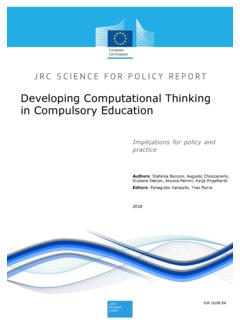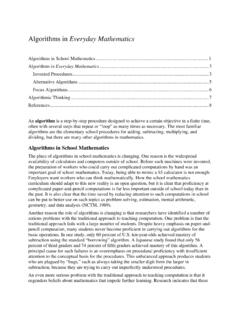Transcription of Defining Computational Thinking for Mathematics …
1 Defining Computational Thinking for Mathematics and ScienceClassroomsDavid Weintrop1,2 Elham Beheshti3 Michael Horn1,2,3 Kai Orton1,2 Kemi Jona2,3 Laura Trouille5,6 Uri Wilensky1,2,3,4 Published online: 8 October 2015 Springer Science+Business Media New York 2015 AbstractScience and Mathematics are becoming com-putational endeavors. This fact is reflected in the recentlyreleased Next Generation Science Standards and the deci-sion to include Computational Thinking as a core scien-tific practice. With this addition, and the increased presenceof computation in Mathematics and scientific contexts, anew urgency has come to the challenge of Defining com-putational Thinking and providing a theoretical groundingfor what form it should take in school science and math-ematics classrooms.
2 This paper presents a response to thischallenge by proposing a definition of computationalthinking for Mathematics and science in the form of ataxonomy consisting of four main categories: data prac-tices, modeling and simulation practices, computationalproblem solving practices, and systems Thinking formulating this taxonomy, we draw on the existingcomputational Thinking literature, interviews with mathe-maticians and scientists, and exemplary computationalthinking instructional materials. This work was undertakenas part of a larger effort to infuse Computational thinkinginto high school science and Mathematics curricularmaterials.
3 In this paper, we argue for the approach ofembedding Computational Thinking in Mathematics andscience contexts, present the taxonomy, and discuss howwe envision the taxonomy being used to bring currenteducational efforts in line with the increasingly computa-tional nature of modern science and Thinking High schoolmathematics and science education STEM education Scientific practices Systems Thinking Modeling andsimulation Computational problem solvingIntroductionBy 2020, one of every two jobs in the STEM fieldswill be in computing(ACM pathways report 2013)The release of the Next Generation Science Standards(NGSS) places a new emphasis on authentic investigationin the classroom, including eight distinct scientific prac-tices (NGSS Lead States2013).
4 While some of thesepractices are familiar to veteran teachers, such as askingquestions and Defining problems, others are less wellunderstood. In particular, the practice of using mathe-matics and Computational Thinking reflects the growingimportance of computation and digital technologies acrossthe scientific disciplines. Similar educational outcomes canbe found in Mathematics standards, such as the CommonCore guidelines, which state that students should be able to use technological tools to explore and deepen their&David for Connected Learning and Computer-BasedModeling, Northwestern University, Evanston, IL 60208,USA2 Learning Sciences, Northwestern University, Evanston,IL 60208, USA3 Computer Science, Northwestern University, Evanston,IL 60208, USA4 Northwestern Institute on Complex Systems, Evanston,IL 60208, USA5 The Adler Planetarium, Chicago, IL 60605.
5 USA6 Center for Interdisciplinary Exploration and Research inAstrophysics (CIERA), Northwestern University, Evanston,IL 60208, USA123J Sci Educ Technol (2016) 25:127 147 DOI of concepts (National Governors Associa-tion2010, p. 7). However, the inclusion of these practices,in and of itself, offers little guidance for teachers who willbe required to realize them in their classrooms. Much of thedifficulty stems from the fact that the practices collectedunder the umbrella term Computational Thinking (Na-tional Research Council [NRC]2010; Wing2006; Papert1996) have not yet been clearly defined. This is especiallytrue for their use in scientific or mathematical contexts asopposed to more general computer science settings.
6 Thereis also active debate and discussion around key questionssuch as: How is Computational Thinking related to mathe-matical Thinking , algorithmic Thinking , or problem solving?How does it relate to the field of computer science? Towhat extent is computer programming involved? Doescomputational Thinking always require a computer?Our aim in this paper is to develop a more nuancedunderstanding of Computational Thinking specifically as itapplies to the mathematic and scientific disciplines and theneeds of high school teachers who are expected to preparestudents for potential careers in these fields. Unlike most ofthe discussion on Computational Thinking to date, whichemphasizes topics from computer science such as abstrac-tion and algorithms, our approach to Defining computationalthinking takes the form of a taxonomy of practices focusingon the application of Computational Thinking to mathemat-ics and science.
7 This approach employs Mathematics andscience as meaningful contexts in which to situate theconcepts and practices of Computational Thinking and drawson the ways mathematicians and scientists are using com-putational Thinking to advance their disciplines. This morerestrictive context allows us to more clearly characterizewhat Computational Thinking is in Mathematics and taxonomy consists of four main categories: datapractices, modeling and simulation practices, computationalproblem solving practices, and systems Thinking describe each of these practices and their constituentcomponents, and we describe what it looks like to demon-strate mastery of each practice.
8 The contribution of this workis to provide an actionable, classroom-ready definition ofcomputational Thinking that draws on existing computationalthinking scholarship and incorporates concepts specificallyfocused on Mathematics and science contexts. In doing so,we provide a framework and shared language that can beused to bring Mathematics and science instruction more inline with their increasingly Computational nature. Further, ingrounding our conception of Computational Thinking inmathematics and science, we narrow the scope of computa-tional Thinking away from generalities, providing a sharperdefinition that is distinct from computer science, yet stillgrounded in authentic, meaningful Computational practicesthat are essential for students to Bring Computational Thinkingto Mathematics and Science Classrooms?
9 A primary motivation for introducing computationalthinking practices into science and Mathematics classroomsis the rapidly changing nature of these disciplines as theyare practiced in the professional world (Bailey and Bor-wein2011; Foster2006; Henderson et ). In the last20 years, nearly every field related to science and mathe-matics has seen the growth of a Computational include Bioinformatics, Computational Statis-tics, Chemometrics, and Neuroinformatics. This rise inimportance of computation with respect to Mathematics ,science, and the broader Science, Technology, Engineer-ing, and Mathematics (STEM) fields has been recognizedboth by those within the STEM education communities andcomputer science education organizations (ACM/IEEE-CSJoint Task Force on Computing Curricula 2013).
10 Bringingcomputational tools and practices into Mathematics andscience classrooms gives learners a more realistic view ofwhat these fields are, better prepares students for pursuingcareers in these disciplines (Augustine2005; Gardner1983), and helps equip students to be more savvy STEM citizens in the future. As Foster (2006), director of theComputation Lab at the University of Chicago, states, allscientists will be adept at applying existing computationaltechniques (p. 419). Further, the varied and applied use ofcomputational Thinking by experts in the field provides aroadmap for what Computational Thinking instructionshould include in the a pedagogical perspective, the thoughtful use ofcomputational tools and skillsets can deepen learning ofmathematics and science content (Guzdial1994; Eisenberg2002; National Research Council2011a,b; Redish andWilson1993; Repenning et ; Sengupta et ;Sherin2001; Wilensky1995; Wilensky et ;Wilensky and Reisman2006).










